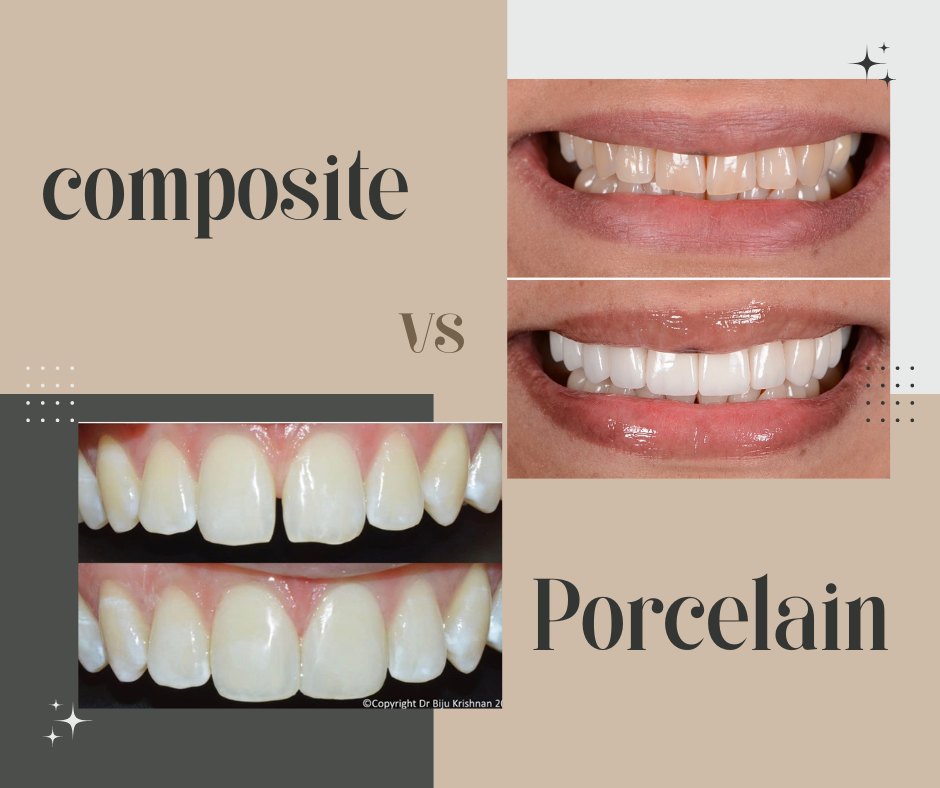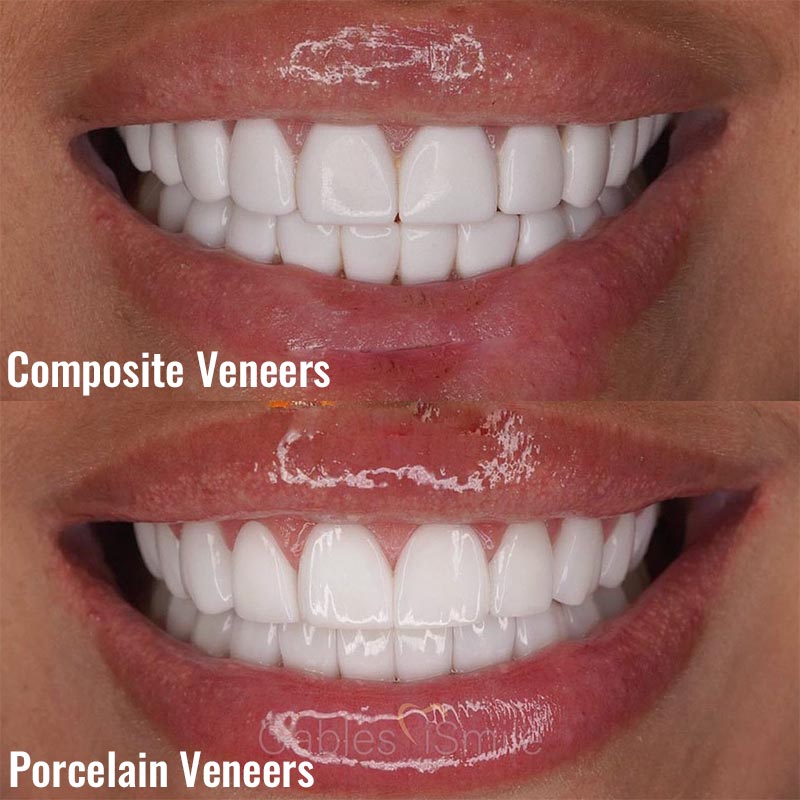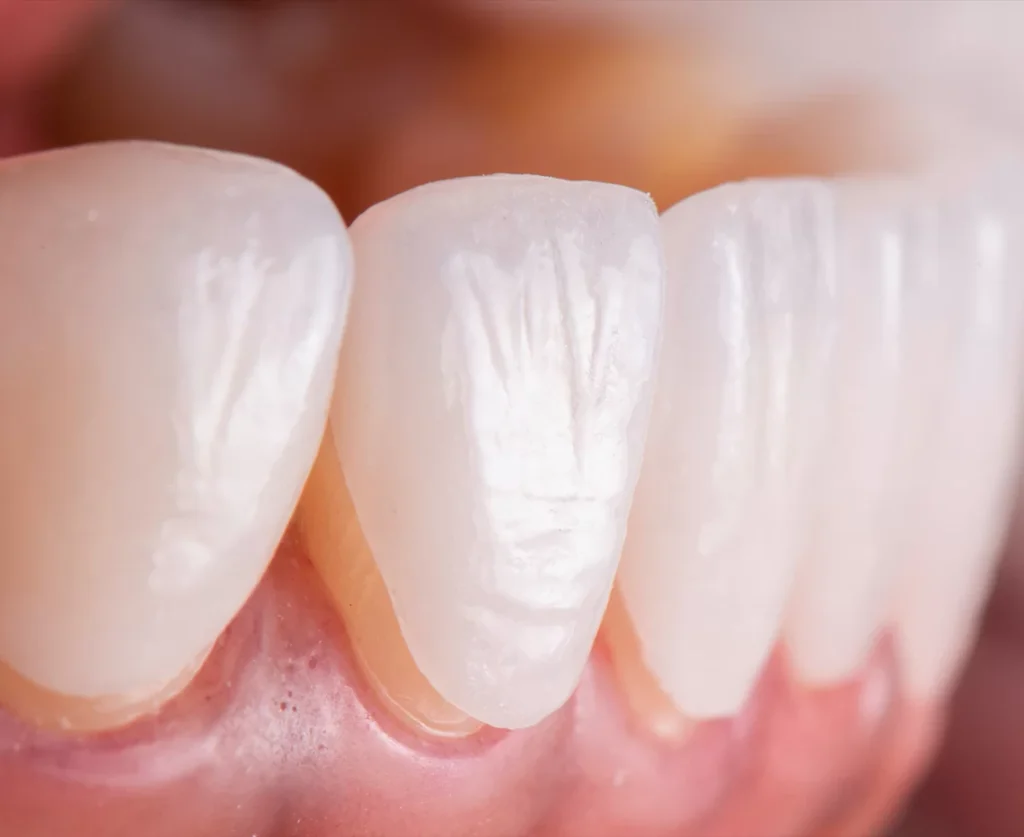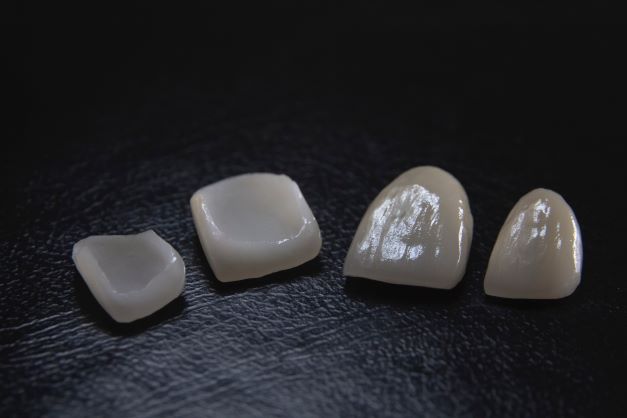
Ceramic veneers are the go-to choice for long-lasting smile makeovers, typically serving you well for 10-15 years with excellent durability. They beautifully mimic natural teeth with their realistic translucency and color depth, maintaining 95% of their original shade over time. Research shows they’re three times stronger than composite versions and boost patient satisfaction by 30%. Just keep in mind they require slightly more tooth preparation (0.3-0.7mm) and usually need two separate appointments to complete.
When comparing porcelain vs composite veneers, composite veneers emerge as the speedy and budget-friendly option, often completed in just one visit with minimal tooth trimming (0.1-0.3mm). They’re perfect if you want quick results or want to preserve more of your natural tooth. But they do come with trade-offs: they last about 5-7 years, may need occasional polishing, and can start discoloring after 2-3 years. Studies show they’re particularly useful when saving your natural tooth structure is the top priority.
In this blog’s porcelain vs composite veneers comparison, we’re putting these options head-to-head to discover which one better suits your smile makeover goals and individual dental needs.
What Are Composite Veneers?
Composite veneers are a direct cosmetic dental treatment where layers of tooth-colored resin are applied to the tooth surface – a process also known as composite bonding. Unlike porcelain veneers, this minimally invasive approach requires no lab work and can typically be completed in just one visit. In the porcelain vs composite veneers comparison, composite veneers stand out as ideal for fixing minor dental flaws, closing small gaps, and correcting discoloration while preserving 80-90% more natural tooth structure than ceramic alternatives, making them a conservative yet effective smile enhancement option.
” Composite veneers have long been used as a conservative and esthetic treatment option for anterior teeth. While they are generally performed using a direct technique, there has been renewed interest in the direct-indirect composite veneer technique because of its advantages and broad indications for restoration of tooth color and morphology. ”
pubmed.ncbi.nlm.nih.gov
Differences Between Composite and Porcelain Veneers
Composite veneers are more affordable and can be fabricated directly on your teeth in a single appointment. However, they typically last only 5 to 7 years and may gradually discolor over time. When comparing porcelain vs composite veneers, porcelain veneers are custom-made in a dental laboratory, require 2-3 treatment sessions, and come at a higher cost, yet they offer superior stain resistance, a more natural appearance, and an impressive 10 to 15-year lifespan. The choice between the two depends on your budget, timeline, and treatment expectations. For a more detailed comparison, consider the following factors:
- Structural & Material Differences
- Porcelain veneers: Made from dental ceramic (feldspathic or lithium disilicate), 0.3-0.7mm thick, fabricated in a lab
- Composite veneers: Crafted from nano-hybrid resin composite, directly shaped and polymerized on teeth
- Porcelain has 2-3x higher compressive strength than composite (400MPa vs 150MPa)
- Treatment Process Comparison
- Porcelain or composite veneers differ significantly in workflow:
- Porcelain: Requires ≥2 visits (tooth prep, impressions, final bonding)
- Composite: Typically completed in one appointment
- Porcelain requires 50% more tooth reduction
- Durability & Longevity
- Porcelain veneers: 10-15 year lifespan with excellent color stability
- Composite veneers: 5-7 year lifespan, needing periodic polishing
- Failure rates: 3-5% for porcelain vs 15-20% for composite over 10 years
- Aesthetic Performance
- Porcelain vs composite veneers comparison reveals:
- Porcelain mimics natural enamel’s translucency and depth
- Composite has limitations in layering enamel/dentin effects
- Color stability: 95% (porcelain) vs 60-70% (composite) over 10 years
Pros and Cons of Porcelain Veneers
At D’Amico Dental Care, we’ve helped countless patients in the Watertown and Wayland areas achieve their dream smiles with high-quality porcelain veneers that deliver stunning, natural-looking results for 10-15 years. In the porcelain vs composite veneers comparison, our porcelain veneers resist stains permanently and blend seamlessly with your natural teeth, with 90% of patients reporting they would choose them again for their beautiful, lifelike appearance and lasting quality.
While porcelain veneers offer exceptional aesthetics, we believe in complete transparency: they do require removing a small amount of enamel (an irreversible step), and they’re an investment in your smile’s future. The process typically takes two comfortable visits at either of our locations, and though durable, we recommend avoiding habits like nail-biting or chewing ice to prevent chips. For most patients in our community, the long-term benefits – a flawless, confidence-boosting smile – far outweigh these considerations.
Advantages of Porcelain Veneers
Porcelain veneers are considered the gold standard in cosmetic dentistry, offering exceptional advantages over other restorative options:
- Unmatched Durability & Strength
✓10-15 year lifespan (vs. 5-7 years for composite)
✓400-600 MPa compressive strength
✓ Wear resistance comparable to natural enamel - Peerless Aesthetics
✓ Translucency and color depth mirroring natural teeth
✓>95% color stability after 10 years
✓ Light reflection properties identical to enamel - Biological Harmony
✓ High resistance to microbial plaque
✓ Reduced gum inflammation (vs. composite)
✓ Immune to stains and pigments - Clinical Versatility
✓ Ideal for major tooth transformations
✓ Perfect for severely discolored teeth
✓ Excellent thermal resistance
The porcelain vs composite veneers comparison clearly demonstrates why porcelain dominates, with studies showing a 92-95% patient satisfaction rate after 5 years, among the highest of any restorative technique in modern dentistry.
Disadvantages of Porcelain Veneers
- Treatment Limitations
- Requires significant tooth reduction (0.3-0.7mm) – an irreversible process
- Risk of post-prep sensitivity, especially near dentin
- Cannot be repaired in-office if damaged (must be fully remade in a lab)
- Clinical Challenges
- Relative brittleness under impact (3-5% fracture rate over 10 years)
- Not suitable for teeth with severe structural loss
- Demands exceptional dental skills for precise preparation
- Economic & Time Factors
- Higher cost (2-3x composite veneers)
- Longer process (minimum 2 visits, 1-2 weeks apart)
- Requires skilled lab technicians for fabrication
The porcelain vs composite veneers comparison reveals important trade-offs, as studies show 15-20% of patients experience temporary sensitivity or require minor adjustments, with potential marginal decay risks if proper oral hygiene is not maintained.
Pros and Cons of Composite Veneers
Porcelain or composite veneers each have their advantages, but composite veneers are particularly appealing for many patients. These resin-based restorations enhance your smile with minimal tooth preparation—sometimes even none at all—making them a less invasive option. Their affordability, single-visit convenience, and easy repairability make them ideal for those seeking quick, budget-friendly results.
However, in dental veneer comparison, composites do have drawbacks. Their 5-7 year lifespan is shorter than porcelain, and they’re more prone to staining and discoloration over time. They also require regular polishing to maintain their appearance. The porcelain vs composite veneers comparison shows that while composite veneers excel for fast, economical smile upgrades, porcelain veneers may be the superior choice for patients seeking long-lasting, stain-resistant results with premium aesthetics.
Benefits of Composite Veneers
In the porcelain vs composite veneers comparison:
- Tooth Preservation & Minimal Intervention
- Requires only 0.1-0.3mm tooth reduction (ultra-conservative)
- Preserves 80-90% healthy tooth structure vs porcelain veneers
- Lowers post-treatment sensitivity risk significantly
- Clinical Versatility & Efficiency
- Single-visit completion (just 60-120 minutes)
- Easy in-office repairs/adjustments (no lab needed)
- Perfect for minor corrections of:
✓ Tooth shape
✓ Color irregularities
✓ Mild positioning issues - Ideal for young patients with healthy enamel
- Economic & Practical Advantages
- 30-50% more affordable than porcelain
- Fewer appointments needed
- Suitable for cosmetic emergencies
Evidence-Based Results:
✓ 85-90% short-term patient satisfaction
✓ 70-75% clinical success rate at 5 years
✓ 40% better wear resistance in next-gen composites vs older versions
Disadvantages of Composite Veneers
While composite veneers offer many benefits, this dental veneer comparison reveals important limitations to consider:
- Limited Longevity
Composite veneers last 5-7 years on average, half the lifespan of porcelain veneers (10-15 years). Their shorter durability stems from lower resistance to chewing forces and daily wear. - Stain Susceptibility
The porous nature of composite resin makes it prone to discoloration from coffee, tea, smoking, and colored foods, especially in patients with poor oral hygiene. - Maintenance Demands
In the porcelain vs composite veneers comparison, composite veneers require professional polishing every 6-12 months to maintain their shine, as without proper care, their surface roughens and becomes more susceptible to plaque and bacterial accumulation. - Fracture Risk
More brittle than porcelain, composites chip or crack more easily – a significant concern for teeth grinders (bruxism patients). - Complex Smile Design Limits
While great for minor-to-moderate changes, composite veneers deliver less predictable results for extreme tooth reshaping or color corrections.
Choosing Between Porcelain and Composite Veneers
In the porcelain vs composite veneers comparison, porcelain veneers offer superior durability (10-15 years), excellent stain resistance, and a natural translucent appearance, though they require more tooth preparation, come at a higher cost, and typically need at least two treatment sessions, making them ideal for patients seeking long-lasting, high-quality results especially for severely discolored teeth.
On the other hand, composite veneers are a more affordable option that can be completed in a single visit with minimal tooth preparation. While they are easily repairable, they have a shorter lifespan (5-7 years) and are more prone to staining. Composite veneers are best suited for patients with budget constraints or those needing quick, temporary smile enhancements. The choice between porcelain and composite depends on individual priorities such as budget, longevity, and treatment time.
| Feature | Porcelain Veneers | Composite Veneers | Clinical Recommendation |
| Durability | 10-15 years (with proper care) | 5-7 years | • Porcelain for long-term investment • Composite for interim solutions |
| Aesthetics | • Natural translucency • Excellent stain resistance |
• Good initial aesthetics • Prone to staining over time |
Porcelain for severe discoloration or high aesthetic demands |
| Tooth Preparation | 0.3–0.7mm enamel removal (irreversible) | Minimal prep (often reversible) | Composite for conservative cases |
| Treatment Time | 2+ visits (lab fabrication required) | Single-visit (direct bonding) | Composite for immediate results |
| Repairability | Difficult (usually requires replacement) | Easily repairable chairside | Composite for patients with bruxism/high risk |
| Clinical Cases | • Tetracycline stains • Large gaps • Worn incisors |
• Small chips • Mild discoloration • Teenagers |
Which Type of Veneer Is Right for Your Needs?
At D’Amico Dental Care, we help patients choose between porcelain and composite veneers based on their unique smile goals. Porcelain veneers are our premium option, offering 10-15 years of stain-resistant, natural-looking perfection – ideal for patients seeking dramatic transformations or covering severe discoloration. Meanwhile, composite veneers provide an affordable, same-day solution for subtle enhancements, though they typically last 5-7 years and require more maintenance.
The porcelain vs composite veneers decision is highly personalized, and our cosmetic dentists in Watertown and Wayland will thoroughly guide you through each option’s unique advantages and considerations during your consultation to determine the ideal choice for your smile goals. We consider your budget, timeline, and desired results – sometimes even combining both materials for optimal value. Whether you choose porcelain’s longevity or composite’s convenience, we’ll create stunning results tailored to your lifestyle.
Factors to Consider Before Deciding
Tooth Condition:
- Porcelain veneers are better for severely discolored teeth needing full coverage
- Composite veneers work well for minor shape/color corrections
Budget Considerations:
- Porcelain has a higher initial cost (but longer lifespan)
- Composite offers more affordable pricing
Treatment Timeline:
The porcelain vs composite veneers comparison shows porcelain typically requires 2-3 appointments while composite can often be completed in just one visit, making it a more time-efficient option for patients with busy schedules.
Aesthetic Expectations:
- Porcelain creates more natural translucency
- The composite may appear slightly less transparent
Lifestyle Factors:
- Porcelain resists stains better (ideal for smokers/coffee drinkers)
- A composite may suffice for temporary solutions
Longevity:
- Porcelain lasts 10-15 years
- Composite endures 5-7 years
Final Recommendation:
This dental veneer comparison shows both options have distinct advantages. To determine whether porcelain or composite veneers best suit your unique dental needs and aesthetic goals, always consult with an experienced cosmetic dentistry specialist for personalized recommendations.
source: www.torrensdental.com
FAQ
- 1. What are the structural differences between porcelain and composite veneers?
Porcelain Veneers:
- Made from high-quality dental ceramic
- Fabricated in specialized dental laboratories
- Thicker (approximately 0.5 mm)
- Requires more natural tooth reduction
Composite Veneers:
- Made from composite resin materials
- Applied directly in the dentist’s office
- Thinner and requires less tooth preparation
- Easier to repair and modify
- How long does each type last?
Porcelain:
- Average lifespan: 10-15 years
- High resistance to staining and wear
- Less prone to cracking
Composite:
- Average lifespan: 5-7 years
- May discolor over time
- Requires periodic polishing
- Which provides a more natural appearance?
Porcelain:
- Translucency and shine similar to natural teeth
- Excellent color matching
- Light reflection comparable to tooth enamel
Composite:
- Good appearance but less translucent
- Immediate color matching with adjacent teeth
- Less shine compared to porcelain
- What are the procedures for each type?
Porcelain:
- Requires 2-3 dental visits
- Impression-taking and laboratory fabrication
- Fitting with special cement in the second visit
Composite:
- Often completed in a single visit
- Direct application of material to the tooth
- Shaping and final polishing in the same session
- What is the price difference between these two methods?
Porcelain:
- Higher cost (typically 2-3 times composite)
- Per unit price: 4-8 million Tomans (depending on quality)
Composite:
- More economical
- Per unit price: 1.5-3 million Tomans
- Lower repair and maintenance costs
- Which is more suitable for different dental problems?
Porcelain is better for:
- Significant tooth discoloration
- Major changes in tooth shape
- Cases requiring long-term durability
Composite is better for:
- Minor shape and color corrections
- Small gaps between teeth
- Patients wanting immediate results
- How should you care for your veneers?
For both types:
- Daily brushing with a soft toothbrush
- Careful flossing
- Avoiding hard foods
- Regular dental checkups
Special care for composite:
- Avoiding staining substances like coffee and tea
- Periodic polishing every 6-12 months
- How to select between these two methods?
Key decision factors:
- Your budget (porcelain is more expensive)
- Required treatment speed (composite is faster)
- Desired level of change (porcelain better for major changes)
- Expected lifespan (porcelain lasts longer)
- Specialist’s recommendation after thorough examination




